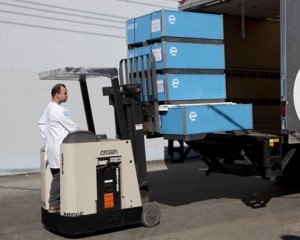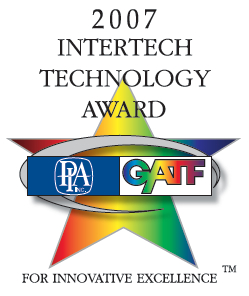“Consumable” - something that may be depleted or worn out by use.
Printers regularly use the term “consumable” to describe supplies that are used in the manufacturing process, such as inks, fountain solutions, blanket washes and press blankets. Until recently, disposal of used consumables has been considered “just the cost of doing business.” Today we look at ways to manage “end of life” for press blankets. It is no longer necessary – or economical – to use them once and throw them away. Let’s consider the cost of consumables for printers using UV. UV printing is not a new process; package printers have used it for years. We are now seeing a migration of UV printing into commercial sheetfed offset, primarily because of its many benefits. For example, UV inks cure quickly, meaning faster turnaround on both single- and two-sided jobs. Print quality is very high, even on difficult substrates; color on uncoated papers is particularly vibrant. Printers can deliver unique or complex effects that take advantage of a wide variety of coatings including gloss, matte, metallic, pearlescent, textured, and microencapsulated coatings. On the downside, commercial sheetfed offset printers have to deal with substantially higher costs of UV printing. The inks are expensive, press chemistry must be carefully adjusted and balanced, and press blankets wear out faster. As press runs get shorter and shorter, the higher costs are more and more difficult to balance against the price of the job. It’s tough to change the way we do business, however we all know that using something once and tossing it into the trash is wasteful. It is ingrained in our workflow processes that a “consumable” is used once; it is consumed and whatever remains is then disposed of. Inks, blanket wash, and blankets are all consumables. And yet it’s possible to recycle waste inks and to recycle or reprocess solvents; some washes can be distilled and reused. It is also possible to filter the washes and use the remaining solids as biodiesel. Unfortunately reusing press blankets has not been an option. Commercial printers changing to UV printing may find their press blanket usage double or even triple after the conversion. As printers make the conversion, they find it difficult to forecast blanket usage; the ink/blanket/chemistry combination, the run length, the quality and frequency of machine maintenance and other variables combine to determine how often blankets need to be changed. At a cost of thousands of dollars more than budgeted, thousands of blankets go into the trash every month. Finding ways to avoid having to buy so many blankets is paramount, whether a printer is adopting Lean Manufacturing where the emphasis is on cutting waste in the manufacturing process or he is simply looking for ways to reduce costs. To eliminate the disposal of thousands of blankets requires the ability to turn used blankets into reusable blankets. Enviro Image Solutions (EIS), Vancouver BC, has developed a patent pending proprietary process that refurbishes dirty blankets used for UV printing and makes it possible to use them again and again. EIS reports that blankets are generally refurbished and returned to production four or five times; some have been refurbished as many as 10 or 12 times. To cut down on the number of blankets they must buy, printers across North America and Japan are joining the refurbishing program. As a first step, they submit 10 blankets for testing. EIS reports that the success rate for processing test lots is about 80%; if a group of blankets falls below that threshold, they are treated with alternative processes.
To increase the success rate, EIS technicians tailor treatment processes to specific variables such as blanket type and source, inks, blanket wash, fountain solutions, and used blanket handling. EIS returns only blankets that have passed stringent quality control tests; any blankets that do not pass the quality requirements - and will perform as if new - are recycled, not put back into use.
To cut down on the number of blankets they must buy, printers across North America and Japan are joining the refurbishing program. As a first step, they submit 10 blankets for testing. EIS reports that the success rate for processing test lots is about 80%; if a group of blankets falls below that threshold, they are treated with alternative processes.
To increase the success rate, EIS technicians tailor treatment processes to specific variables such as blanket type and source, inks, blanket wash, fountain solutions, and used blanket handling. EIS returns only blankets that have passed stringent quality control tests; any blankets that do not pass the quality requirements - and will perform as if new - are recycled, not put back into use.
 After a successful test, the printer is sent one or more “transport cells” in which to store refurbished blankets and to ship dirty blankets to Vancouver. As long as the blanket has not been cut, scored or damaged in some way it can be refurbished over and over again.
Even though refurbished blankets work as well as new ones and cost about one-third as much, it can be a challenge for pressmen to accept the blankets as equal to new. They don’t look new; there is a shadow from previous use, but the latent image is gone and they work like new.
Used blankets need to be handled carefully. They shouldn’t be thrown in a pile in the corner and the edges of the bar should be taped to avoid cutting other blankets as they are stacked. The transport cells are designed to make it easy to deliver refurbished blankets, to protect the refurbished blankets before use, and to store used blankets to be returned for cleaning.
After a successful test, the printer is sent one or more “transport cells” in which to store refurbished blankets and to ship dirty blankets to Vancouver. As long as the blanket has not been cut, scored or damaged in some way it can be refurbished over and over again.
Even though refurbished blankets work as well as new ones and cost about one-third as much, it can be a challenge for pressmen to accept the blankets as equal to new. They don’t look new; there is a shadow from previous use, but the latent image is gone and they work like new.
Used blankets need to be handled carefully. They shouldn’t be thrown in a pile in the corner and the edges of the bar should be taped to avoid cutting other blankets as they are stacked. The transport cells are designed to make it easy to deliver refurbished blankets, to protect the refurbished blankets before use, and to store used blankets to be returned for cleaning.
 Press blanket rejuvenation reduces the need for new blankets by 80% to 90% and it keeps the blankets in use for 5 to 10 times longer than before. When the blanket must be “retired,” the metal can be removed and recycled and the rubber repurposed as material to make highways and track field surfaces, as well as used as an alternative fuel to generate power.
While EIS recycles only the blankets they receive that cannot be refurbished, the staff will work with printers to help them find local recyclers to handle blankets when they must be disposed of. Each locality is different and local recyclers may or may not recycle or incinerate the rubber from the blankets.
Pressmen should not be afraid to use refurbished blankets. Metropolitan Fine Printers, Vancouver, a winner of multiple industry awards - including the coveted Benjamin Franklin Awards (Bennys) – uses refurbished blankets. Metropolitan prints 10-micron stochastic high definition screening as a standard process.
Mike Winteringham, Vice President of Metropolitan, said, “Any job will go on any blanket – new or refurbished. Even our Benny-winning jobs have been printed with refurbished blankets. So could you say we risk our Bennys when we use refurbished blankets? I don’t think so, we use the blankets as a matter of course.”
Press blanket rejuvenation reduces the need for new blankets by 80% to 90% and it keeps the blankets in use for 5 to 10 times longer than before. When the blanket must be “retired,” the metal can be removed and recycled and the rubber repurposed as material to make highways and track field surfaces, as well as used as an alternative fuel to generate power.
While EIS recycles only the blankets they receive that cannot be refurbished, the staff will work with printers to help them find local recyclers to handle blankets when they must be disposed of. Each locality is different and local recyclers may or may not recycle or incinerate the rubber from the blankets.
Pressmen should not be afraid to use refurbished blankets. Metropolitan Fine Printers, Vancouver, a winner of multiple industry awards - including the coveted Benjamin Franklin Awards (Bennys) – uses refurbished blankets. Metropolitan prints 10-micron stochastic high definition screening as a standard process.
Mike Winteringham, Vice President of Metropolitan, said, “Any job will go on any blanket – new or refurbished. Even our Benny-winning jobs have been printed with refurbished blankets. So could you say we risk our Bennys when we use refurbished blankets? I don’t think so, we use the blankets as a matter of course.”
 Environmentally aware manufacturers produce less waste by buying products that are less toxic or contain less packaging, using reusable containers and other reusable items, maintaining and repairing products, participating in recycling programs, and buying products made from recycled materials. Putting waste into landfills should only occur when there is no other alternative. Even the EPA’s Pollution Prevention Act of 1990 states “disposal or other release into the environment should be employed only as a last resort and should be conducted in an environmentally safe manner.”
Refurbishing press blankets reduces the need to buy so many new blankets and reuses used blankets as if they were new, allowing for recycling when they can no longer be rejuvenated, and avoids the last choice - disposal - whenever possible.
Environmentally aware manufacturers produce less waste by buying products that are less toxic or contain less packaging, using reusable containers and other reusable items, maintaining and repairing products, participating in recycling programs, and buying products made from recycled materials. Putting waste into landfills should only occur when there is no other alternative. Even the EPA’s Pollution Prevention Act of 1990 states “disposal or other release into the environment should be employed only as a last resort and should be conducted in an environmentally safe manner.”
Refurbishing press blankets reduces the need to buy so many new blankets and reuses used blankets as if they were new, allowing for recycling when they can no longer be rejuvenated, and avoids the last choice - disposal - whenever possible.
 We’re changing our attitudes about how we deal with waste, and companies like EIS are being recognized for their contributions to reducing waste in the manufacturing process. In 2007, Enviro Image Solutions won an Intertech Award for their blanket refurbishing process.
For more information, visit Enviro Image Solutions.
We’re changing our attitudes about how we deal with waste, and companies like EIS are being recognized for their contributions to reducing waste in the manufacturing process. In 2007, Enviro Image Solutions won an Intertech Award for their blanket refurbishing process.
For more information, visit Enviro Image Solutions.









